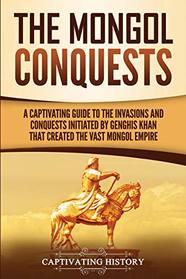Thank you to the author(s) for adding maps, drawings, etc., to this book. They add so much to one's understanding of the time, people and events discussed in the story. I am particularly glad that I read your book on Genghis Khan before reading this work about the whole Mongol Empire. Going from particular (Genghis Khan) to general (the whole empire) seemed to make things much more interesting and understandable.
Khan created a Eurasian empire from Hungary to Korea. Because only 1% of the land is tillable, agriculture has never been a major occupation in the Eurasian Steppes. Pastoral nomadism is the dominant way of life In the late 3rd century BCE, the first major tribal confederation of the nomadic peoples was formed but wars dominated the area until Genghis Khan unified the large areas in the 12th century CE (through oodles of wars).
This book is longer than the one on Genghis Khan (136 vs. ~ 97) and it is full of fascinating accounts. I thought the story about the Russian princes deciding to wage war against the Mongols (who were just returning home and not in the mood for fighting) was indicative of the amazing strength and stamina of the Mongol fighting force. In three years, the Mongols traveled 5,500 miles and won seven major battles, each against enemies with superior numbers.
Another standout chapter was the section that explained "The Mongol War Machine." As the Mongols captured other lands and peoples, they had a great system for including them into the Mongol system. The Mongols weren't just amazing horsemen, but they adapted to new fighting methods that they encountered and included those new weapons by taking the captured engineers, instead of killing them.
Genghis Khan understood that the Mongol system of governance of nomadic tribes would not work with more sedentary settlements. Thus, he instituted a system of governors who were subservient to the khan but had local control of the population. One of the smartest rules Khan had was the tolerance of religion in his conquered peoples. Religion probably causes more conflict than any other subject. Thus, trade was not hampered by conflicts over beliefs. Because of the safe passage and good roads within the Mongol-controlled lands, knowledge, arts, and other cultural exchanges took place across Asia. An interesting sideline to the Mongol story is the fact that women, amongst the Mongols, had more rights than most women in the world at that time.
Finally, I thought the conclusion of the book was particularly fine. Thank you for a great reading experience.
Khan created a Eurasian empire from Hungary to Korea. Because only 1% of the land is tillable, agriculture has never been a major occupation in the Eurasian Steppes. Pastoral nomadism is the dominant way of life In the late 3rd century BCE, the first major tribal confederation of the nomadic peoples was formed but wars dominated the area until Genghis Khan unified the large areas in the 12th century CE (through oodles of wars).
This book is longer than the one on Genghis Khan (136 vs. ~ 97) and it is full of fascinating accounts. I thought the story about the Russian princes deciding to wage war against the Mongols (who were just returning home and not in the mood for fighting) was indicative of the amazing strength and stamina of the Mongol fighting force. In three years, the Mongols traveled 5,500 miles and won seven major battles, each against enemies with superior numbers.
Another standout chapter was the section that explained "The Mongol War Machine." As the Mongols captured other lands and peoples, they had a great system for including them into the Mongol system. The Mongols weren't just amazing horsemen, but they adapted to new fighting methods that they encountered and included those new weapons by taking the captured engineers, instead of killing them.
Genghis Khan understood that the Mongol system of governance of nomadic tribes would not work with more sedentary settlements. Thus, he instituted a system of governors who were subservient to the khan but had local control of the population. One of the smartest rules Khan had was the tolerance of religion in his conquered peoples. Religion probably causes more conflict than any other subject. Thus, trade was not hampered by conflicts over beliefs. Because of the safe passage and good roads within the Mongol-controlled lands, knowledge, arts, and other cultural exchanges took place across Asia. An interesting sideline to the Mongol story is the fact that women, amongst the Mongols, had more rights than most women in the world at that time.
Finally, I thought the conclusion of the book was particularly fine. Thank you for a great reading experience.




